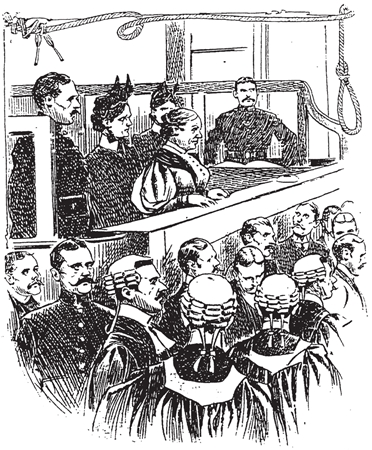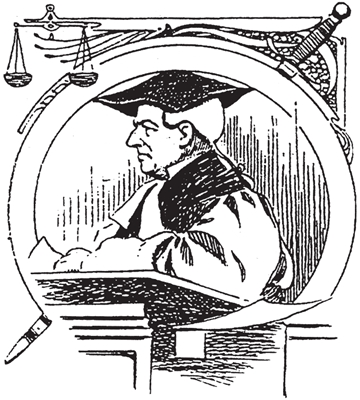
Dyer stands for the verdict, Famous Crimes, 1905
The Old Bailey in 1896 was situated a few hundred yards northwest of St Paul’s Cathedral and was named after the street which ran alongside it. Newgate Gaol stood next door and this close proximity allowed prisoners to be easily transported to the courtrooms for their trials.
The trial of Amelia Dyer, indicted for the wilful murder of Doris Marmon and Harry Simmons, took place in the Old Court on 21 and 22 May 1896 in front of Mr Justice Hawkins, with her daughter Mary Ann Palmer standing as the main witness against her.
Sir Henry Hawkins was known on the court circuit to be a harsh judge but with an eccentric side to his nature. His dog accompanied him everywhere and sat hidden in his robes during trial. It was well known that “m’lud’s dog” was a fine companion who conducted himself with “judicial gravity”.
The accused woman, who had confessed to the killings but was pleading insanity, looked a good deal older and thinner than she had appeared at Reading. Standing in the dock in a plain black dress and without bonnet, her hair scraped back into a knot, Amelia Dyer listened as Evelina Marmon and Mary Ann Beattie gave their evidence. She was subdued and pale, only looking up once and flushing momentarily when her daughter appeared, taking her place in a witness box hung with various items of infant apparel connected to the case.
Polly had changed considerably since being taken into custody, her cool demeanour replaced by a harassed look.. “She was a good deal paler than at her previous appearance,” reported the Weekly Dispatch on 24 may 1896, “and the absence of toilet requisites in H.M. prisons interfered a good deal with her attractiveness.” She retold the story of Mother’s visit to Mayo Road in a quiet but clear and distinct voice. She was asked to explain how the items of clothing that had once belonged to Doris Marmon and Harry Simmons had ended up at her own house and she told of how Mother had brought them, saying she had made them for Polly’s own nurse child, Harold. She had received £12 when she had adopted little Harold.
Justice Hawkins asked her if she had really wanted to adopt a child.
“Yes,” she replied.
“Then why not take it without any money?”
Polly had no answer to this question.
The prosecution asked Polly to repeat what her mother had said about the child Harry Simmons after they had collected him from Paddington Station. With a degree of reluctance she told how Mother had called it a “little Devil”, shook it because it was fretful and said she “shouldn’t keep it”.
Cross-examined by Mr Kapadia, Polly ended the day by telling how Mother had been confined in the Gloucester and Wells Asylums and how she often suffered from delusions.
When the trial resumed the following day, Polly was once again called to the witness box and told the court of the many children her mother had taken in to nurse throughout the years and the many changes of address. She told of how her mother had gone into an asylum on two occasions when pressure was being put upon her by the parents of a child she had “adopted”. She was rigorously questioned as to the number of children Mother had at her different residences, but could give no satisfactory answer.
Mrs Sargeant, Mr and Mrs Culham, John Toller, Granny Smith, Dr Maurice, DC Anderson and Miss Gibbs, the prison matron, were all called to repeat the evidence already given at Reading. The prosecution closed their case by suggesting that Amelia Dyer had carried on a business of “trafficking in infants”, for which she received premiums, and that afterward she strangled the infants and disposed of the bodies in the Thames.
It was down to Mr Kapadia to prove that Amelia Dyer had been “unaccountable for her actions” at the time of the murders. But it was an impossible task. The evidence of Dr Forbes Winslow was flimsy and two doctors who had attended to Amelia during her time in the asylums were unable to lend weight to her cause.
Dr Scott of Holloway Prison and the eminent specialist Dr Savage rebutted the evidence for the defence. Both had examined Amelia Dyer and both were of the opinion that she was perfectly sane at the time of the murders.
Mr Kapadia attempted to strengthen Amelia Dyer’s plea of insanity by telling the court that her own mother, Sarah Hobley, had died a lunatic. When Amelia was eleven her mother had died of typhus and in her final days had suffered a complete mental collapse. Amelia remembered only the madness and not the typhus which had caused it. The prosecution then called Dyer’s brother, James Hobley. He was the last witness to stand in the box and told the court he had been estranged from Dyer for thirty-five years and requested that his name be kept out of the press. He told the court, “My mother was never insane – there was never a case of insanity in our family, so far as I have heard our family history.”

Dyer stands for the verdict, Famous Crimes, 1905
The trial of the “Reading Baby Farmer” had finally come to an end and the lights of the court were lowered as the jury exited to consider their verdict. The only sound to be heard was the ticking of the courtroom clock reverberating around the walls of the sombre room. After only four and a half minutes the jury returned with a verdict of “Guilty”.

Justice Hawkins pronouncing the death sentence, Famous Crimes, 1905
The colour drained from Amelia Dyer’s face as Justice Hawkins donned the black cap and in solemn and measured tones pronounced the death sentence. The muscles of her face twitched and she began to rock backwards and forwards on her feet before being assisted from the dock and led out of court.